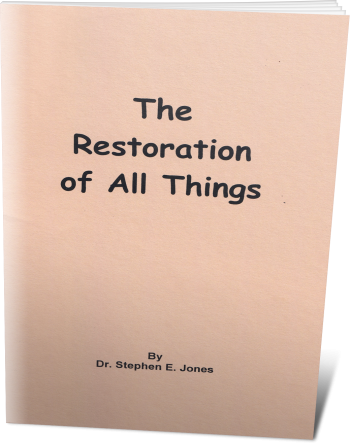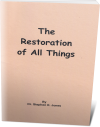Latest Posts
View the latest posts in an easy-to-read list format, with filtering options.

The Bible says that every knee will bow to Jesus Christ and that God has committed to Jesus all judgment. How will God accomplish this purpose? Will He do this by refusing to judge mankind for sin? Or will He do it through His judgments? This booklet shows the difference between Universalism, which denies all divine judgment, and Restorationism, which teaches that the judgments of the law are corrective and restorative.
Category - General

The Bible focuses primarily upon the history of the Birthright, which originally included the Dominion Mandate--the right to rule the earth that was passed down from Adam to succeeding generations. This Dominion Mandate ended with Jesus Christ, under whose feet were put all things.
For this reason, the Bible is mostly about the history of Israel and Judah, and it mentions other nations only as they come into contact with them. But this does not mean that God has no concern for other nations. Adam was given universal dominion, not just a little garden somewhere in the Middle East. Likewise, that same universal dominion has been given to Jesus Christ, who is King over all. Isaiah 54:5 says that the Redeemer of Israel is “the God of the whole earth.”
The Bible speaks of five specific covenants in progressive order that establish the great plan to bring all things under the feet of Christ. The word of the Lord will always be fulfilled, and God made many “promises” and “vows” as well. But the first time the word “covenant” is used in the Bible is through Noah in Genesis 9:9 and 10,
9 Now behold, I Myself do establish my covenant with you and with your descendants after you; 10 and with every living creature that is with you, the birds, the cattle, and every beast of the earth with you; of all that comes out of the ark, even every beast of the earth.
This covenant is not only with Noah and sons (man), but also with the birds, cattle, and beast of the earth. They all will benefit from this covenant quite literally. But more than this, these four categories of living species represent the whole earth. The scope of this covenant is explained in verses 16 as “every living creature of all flesh that is on the earth.” Verse 17 says that the covenant was “established between Me and all flesh that is on the earth.”
The continual repetition of this between verses 9 and 17 is to make sure we understand the universal scope of this covenant. All of this repetition makes one wonder if God knew most people would miss it.
The four categories specifically mentioned each have a head, or leading creature. Noah and sons represent MAN in general; the king of the birds is the EAGLE; the king of the cattle is the OX; and the king of the beasts is the LION. These creatures, then, appear as representatives of creation surrounding the throne of God in Rev. 4:7,
7 And the first creature was like a lion, and the second creature like a calf, and the third creature had a face like that of a man, and the fourth creature was like a flying eagle.
It was anciently understood also that these were the banners (Num. 2:2) of the four leading tribes of Israel surrounding the tabernacle of Moses in the wilderness. To the east was Judah, the lion (Gen. 49:9; Num. 2:3). To the west was Ephraim, the ox (Deut. 33:17; Num. 2:18); to the south was Reuben, the man (Gen. 49:3; Num. 2:10); and to the north was Dan, the flying eagle carrying away a serpent (Gen. 49:17; Num. 2:25).
The order of encampment around the tabernacle under Moses was meant to portray on earth that great heavenly temple revealed in Rev. 4:7. Yet it was all a revelation of the divine covenant with all of creation given in Genesis 9.
This is also the same vision that Ezekiel received in his first chapter. The prophet was looking toward the north (Ez. 1:4) and saw a vision of the throne of God with the four living creatures positioned even as the tribes of Israel around the throne. Verse 10 says,
10 And for the form of their faces, each had the face of a man (Reuben), all four had the face of a lion on the right (Judah on the east as one faces north) and the face of a bull on the left (Ephraim on the west), and all four had the face of an eagle (Dan).
Thus, we have three distinct witnesses—Moses, Ezekiel, and John—who tell us that the four living creatures in the covenant with Noah are represented around the throne of God. Although the tribes of Israel depict this in their order of encampment, they are essentially acting as types that represent the whole earth. What God did with the single nation of Israel was a type of a much bigger divine plan.
The covenant with Noah is the first in the Bible, and it establishes the scope of God's plan for the whole earth. It is the covenant of the Restoration of All Things, for it is the covenant with every living creature of all flesh. Thus, when we finally come to the end, John sees a great vision of this reconciliation in Revelation 5.
In verses 8-12 he sees the overcomers (those who “reign upon the earth”) in agreement with God, saying in verse 12,
12 Worthy is the Lamb that was slain to receive power and riches and wisdom and might and honor and glory and blessing.
But then John sees a greater company of people in verses 13 and 14,
13 And every thing which is in heaven and on the earth and under the earth and on the sea, and all things in them, I heard saying, “To Him who sits on the throne, and to the Lamb, be blessing and honor and glory and dominion forever and ever.” 14 And the four living creatures kept saying, “Amen.” And the elders fell down and worshipped.
In The Expositor’s Bible, Vol. 6, p. 854, published by Eerdman’s Publishing Co., Rev. William Milligan, D.D. explains this as follows:
“What a sublime conception have we here before us! The whole universe, from its remotest star to the things around us, and beneath our feet, is one—one in feeling, in emotion, in expression; one in heart and voice. Nothing is said of evil. Nor is it thought of. It is in the hands of God, who will work out His sovereign purposes in His own good time and way. We have only to listen to the universal harmony, and to see that it moves us to corresponding praise (v. 14).
“The redeemed creation is once more singled out for special mention. At chap. iv. 8, 10, they began the song; now we return to them that they may close it. All creation, man included, cries, Amen. The glorified Church has her heart too full to speak. She can only fall down and worship.”
According to the Commentary on the Whole Bible, page 567 (Zondervan, undated),
“As in ch. 4.11, the four and twenty elders asserted God’s worthiness to receive the glory, as having created all things, so here the four living creatures ratify by their 'Amen' the whole creation’s ascription of the glory to Him.”
This is an astonishing admission from Bible commentators who are forced by John’s clear language to say that all of creation will one day be in agreement with God and will glorify Him—not from the pits of hell, but from the glory of a new heaven and a new earth.
This is also what Paul meant in Phil. 2:10 and 11 when he said that every knee would bow and every tongue confess “to the glory of God the Father.” There is no glory in forcing everyone to confess the truth. The glory is in the fact that all of creation will come into AGREEMENT with a resounding “AMEN!” In fact, the divine plan is not completed until the four beasts say AMEN to the glory of God.
All of the other covenants after Noah build upon this first covenant and add details to the divine plan. The covenant with Abraham establishes the people THROUGH WHOM this divine plan will be established. That is, the seed of Abraham, first physical and then spiritual, are the ambassadors of Christ with the word of reconciliation to the rest of the world.
Later, the covenant with Moses establishes the standard of righteousness to which all shall attain. The Ten Commandments under the Old Covenant turn into the Ten Promises of the New Covenant. They are promises that we shall not murder, steal, or covet. In the New Covenant God takes upon Himself the responsibility to bring all men into perfection. The law—including the very spirit and intent of the law—is prophetic of what our nature will show forth in that day.
The covenant with David establishes the throne--that is, it establishes who will RULE this Kingdom. The highest dominion, of course, is given to Jesus Christ Himself, who received the Dominion Mandate, which was the calling of the house of Judah and specifically of David.
Finally, the New Covenant was ratified by the blood of Christ on the cross to make all of the previous covenants possible and to redeem all of creation. Without the cross, all of the previous covenants would fail. But Col. 1:16-20 says,
16 For by Him all things were created, both in the heavens and on earth, visible and invisible, whether thrones or dominions--all things have been created by Him and for Him. . . . 20 and through Him to reconcile all things to Himself, having made peace through the blood of His cross; through Him, I say, whether things on earth or things in heaven.
The context of this great reconciliation tells us that the phrase “all things” means all that was created, whether in heaven or in earth. It was all created FOR HIM, and because He redeemed all that was lost in Adam, all things will indeed be given to Him in the end. That is the astounding plan of God for the earth.